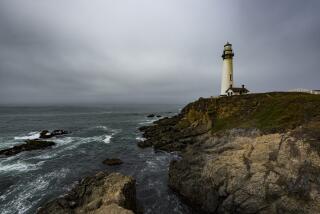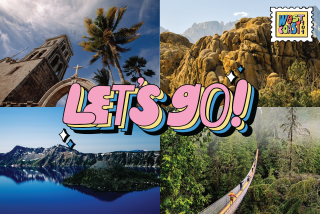Novel Journey
- Share via
ROBINSON CRUSOE ISLAND, Chile — It’s late afternoon and I’m hiking deep in a rain forest when I hear a low growling, half pit bull, half electrical generator. It can’t be a large animal--the largest forest-dwellers on this island are goats--but my heart is racing anyway. Tentatively, I move on.
Ducking into a small canopied grove of tree ferns, I spot the source of the sound, a softball-size red blur headed directly toward me. The hummingbird stops 2 feet in front of my face and hovers there, glaring. To my left is a second, smaller hummingbird, the green female of the species. They are two of only 250 Juan Fernandez hummingbirds in the world, all of which live here on the island, and I do believe I’ve interrupted their mating ritual. After a 30-second stare-down, the male zips away.
Nearly everywhere you go on Robinson Crusoe Island, 415 miles off the coast of Chile, you are confronted by exotic flora and fauna. The island, the only inhabited one of the three in the Juan Fernandez Archipelago, is home to more than 100 native species of plants and animals. This biological diversity is impressive, but the island’s real claim to fame, and the reason I visited, is its legendary guest.
Castaway Alexander Selkirk, the real-life inspiration for Daniel Defoe’s fictional “Robinson Crusoe,” was marooned here for more than four years beginning in 1704. For survival, he had little more than a gun, a knife, a kettle and a Bible. The resilient if wild Scotsman actually asked to be dropped off on the island after a dispute with his captain and survived by eating cabbage and goat meat, living in a cave and presumably developing a healthy relationship with himself.
I traveled to Isla Robinson Crusoe, as it’s called in Chile, in February, intent on reliving Selkirk’s experience, fueled by my reading of “Robinson Crusoe” when I was a boy. My plan was to maroon myself there for four days with only a copy of “Crusoe,” a change of clothes, a camera and, well, a lot of other stuff, actually. I wouldn’t be living off wild blackberries and wearing and sleeping on goatskins as Selkirk had, but at least I’d be walking in his footsteps and pondering the same vast blue horizon. Because I was already headed to Chile for two weeks in January, the excursion would be relatively convenient, or so I thought.
Getting to Isla Robinson Crusoe is an adventure in itself. Tourist traffic to this island of 550 is scant--about 50 people a year--so the only way to travel here is by boat (a two-day trip) or on one of the charter flights that arrives two to three times a week during the warm, dry summer (December to February). After some searching, I found a travel agent in Santiago who could book a round-trip ticket on Lassa airlines for $400. I booked room and board for $200 more.
The morning of my flight I headed to Tobalaba Airport, a tiny airstrip in the southeastern suburbs of Santiago that could easily be mistaken for someone’s backyard. I found only two people at the Lassa office, a janitor and a secretary. Fortunately more staffers soon arrived, and, after my baggage was weighed (the weight limit is 22 pounds per person), I squeezed into a six-seat Cessna along with four Chilean backpackers and the pilot.
Two hours later, the dark, wrinkled contours of the island appeared. From the air, Robinson Crusoe Island (which was known as Mas a Tierra until it was renamed for tourist reasons in 1966) looks uninhabited and nearly uninhabitable. Vertical volcanic cliffs plunge into the ocean, serrated peaks jut into the sky, and the shoreline is rocky and inaccessible. This rugged topography is not surprising considering that the archipelago once was an underwater mountain range. It looked like a perfect setting for “Jurassic Park III,” and I half expected to see pterodactyls swooping through the clouds.
Dipping into a frighteningly steep bank turn, our pilot cruised down onto the stunted landing strip. After a short, dusty hike, we joined five other arriving passengers aboard a small boat bound for San Juan Bautista, the only town on the island. I grabbed a seat on deck for the 90-minute ride and admired a group of native fur seals, or “sea wolves” as Chileans call them, as they bodysurfed in the bay.
About halfway through the ride, a 60ish blond woman who had been diligently photographing the imposing coastal cliffs with her digital camera approached me. “Do you happen to speak English?” she asked.
After two weeks of mangling Spanish, I was excited to hear my mother tongue. Hannah was a Danish traveler who had just come from Antarctica and had an endearing habit of responding to everything I said with a hearty “Yes! Yes!” She was ecstatic about the chance to explore the island from her base at the Villa Green, a small hotel in San Juan Bautista.
My reservations were across the bay at Hosteria El Pangal, a secluded hotel accessible from town only by motorboat or by a strenuous but scenic 45-minute walk. Fortunately, the hotel staff knew I was coming, and Eduardo, El Pangal’s handyman and aquatic chauffeur, was waiting for me in a small boat when we docked in San Juan Bautista. “Ah, we have a gringo!” he said with a smile as he grabbed my backpack. In Mexico this would have been an insult, but in Chile “gringo” just means a foreigner and usually has positive connotations.
We talked in a mixture of Spanish and English while skipping across the water toward the hotel, a boomerang-shaped structure wedged into the base of an eroded canyon. It is a dramatic but precarious location; the hotel looks one landslide away from tumbling into the ocean. Still, the view is gorgeous and the rooms are adequate. My room was a small but comfortable single furnished with a bunk bed and a reading lamp. The community bathroom was not a problem, except that the generator didn’t come on until evening, making the windowless bath a touch-and-feel adventure even during the day.
A grandmotherly hostess named Lala greeted me, showed me around and asked what time I wanted to shower (so she could turn on the hot water) and when I wanted to eat dinner. Important questions, considering I was the only guest at the hotel that night.
I spent the afternoon exploring the town, which radiates out from a central plaza bordered by the post office, the dock and the main thoroughfare. Across the street are a row of one-room general stores, a few restaurant/hotels (none as luxurious as El Pangal) and the island’s only working public telephone, which, amazingly, allowed me to call internationally using my telephone credit card.
After exploring a bit, I stopped at an outdoor bar for a Cristal, the ubiquitous Chilean beer, and soaked in village life. An old woman walked by with a small octopus on a hook, a group of local men gathered for a game of pickup soccer, a motley assortment of dogs chased one another around the dirt roads, and someone played a Cyndi Lauper album, indicative of the islanders’ love of cheesy American music.
As towns go, San Juan Bautista lends new meaning to the term “sleepy.” From what I could tell, villagers spend most of their time sitting around when they’re not lounging, strolling aimlessly, strategically reclining, taking a load off or shooting the breeze. I can’t blame them. Out here in the middle of the Pacific, there’s no reason to hurry and nowhere to go. The island is only 58 square miles, and there are only six cars. The local economy revolves around seasonal fishing for langostas, the pincerless lobsters that populate the offshore waters. Catching them requires little more than setting out traps in the morning and pulling them up at night, so people have a lot of time in between.
That night I dined like a king at my hotel. Sitting facing the ocean, I enjoyed a sumptuous meal that was accompanied by the kind of slow, tropical sunset that honeymooners dream about. The first course was half a lobster, served, as is the custom, cold and with mayonnaise. It was followed by lobster stew and then lobster empanadas (stuffed, baked hot pockets). I was surprised when dessert didn’t contain any lobster. In fact, all three of my dinners at El Pangal were overrun with fresh lobster, with the occasional addition of vidriola, a tasty local fish.
The next morning the hotel rooster awakened me. I got up, packed a lunch and set off across the island intent on hiking up to Selkirk’s Lookout, the ridge about 2,000 feet above town that the castaway scaled daily in hopes of spying a ship. From the center of town, I followed signs past rickety wooden houses and onto a steep trail bordered on both sides by impenetrable walls of blackberry bushes and maqui shrubs that give way to forest and ferns. On my way up I ran into Hannah, who was enjoying the hike but was a little worried. She had spent a large chunk of her cash that morning on fresh lobsters (at $28 a pop) to take home, then discovered that credit cards aren’t accepted on the island. “Lucky for me, there’s not much else to buy around here,” she said with a grin.
The 90-minute ascent to the lookout was tiring and at times treacherous. I can’t imagine what it must have been like for Selkirk as he slashed his way through the vegetation using only a knife. Reaching the summit was like coming up for air. I emerged from dense, damp foliage onto a bare patch of rock that afforded a breathtaking view of both sides of the island. Up here on the peaks, the forest clings like moss to the sheer hillsides and is so thick that once, while chasing a goat, Selkirk plunged over a cliff hidden by trees. (The goat’s body broke his fall and saved his life.)
Hannah joined me on the walk back down, and we ventured onto a poorly marked “alternative trail,” which turned out to be little more than a quarter-mile-long tunnel through the maqui. After nearly getting decapitated by numerous branches, I gratefully crawled back onto the main trail. A beaming Hannah emerged a moment later and exclaimed, “Ah, yes! Wasn’t that fun!” She was, I decided, definitely a glass-is-half-full woman.
The hike to the lookout is the most rewarding excursion on the island, but there are plenty of other options. A scuba shop offers spearfishing, snorkeling and diving expeditions. There is good fishing on the coast, and a couple of trails lead over to the uninhabited western side of the island.
On my second day, I chartered a motorboat ($15) to take me to Puerto Ingles, a rocky beach on the northern side of the island where there is a reconstruction of Selkirk’s makeshift abode. The shelter isn’t much to look at, a slight wooden frame propped against a shallow cave, but once my imagination populated it with drying goatskins, bundles of wild turnips, primitive furniture and Mr. Selkirk, it became quite a vision in my mind’s eye. Exploring the rest of the beach, I stumbled upon several half-buried iron cannons, the remnants of 18th century pirate battles.
I spent my third morning on the hotel deck, reading “Crusoe” and various accounts of Selkirk. According to Richard Steele, a British author who spoke with Selkirk after his rescue, the man quickly became disillusioned when he returned to society. On the island, Steele said in an article published in 1713, Selkirk’s “manner of life grew so exquisitely pleasant that he never had a moment heavy upon his hands; his nights were untroubled and his days joyous.” But once back in Britain, “The man frequently bewailed his return to the world, which could not, he said, with all its enjoyments, restore him to the tranquillity of his solitude.”
That afternoon I hiked up to Plazoleta El Yunque, a picnic area about half an hour away that borders some of the most beautiful rain forest on the island. Heading off the trail a bit, I found a comfortable creek-side spot where I sat down in the shade. All around me, hummingbirds whizzed through the native tree ferns, fantastic plants that look like palm trees with green umbrellas sprouting from their hides. Relaxing in nature’s lap, far removed from beeping pagers, crowded freeways and bickering politicians, I realized that maybe, just maybe, Selkirk had the right idea.
GUIDEBOOK
Marooned on Crusoe’s Isle
Getting there: For information on getting to Santiago, Chile, see the Guidebook for Easter Island on page L13. Two airlines fly to Robinson Crusoe Island out of Tobalaba Airport in suburban Santiago: Linea de Aeroservicios S.A., or Lassa, telephone 011-56-2-273-1458 (ask for Alejandra), fax 011-56-2-273-4309; and Aereos Isla Robinson Crusoe, tel. 011-56-2-531-3772. Air fare is about $400 round trip.
Where to stay: The nicest hotel on the island is Hosteria El Pangal, which can be booked through the Lassa airline number above. Private rooms can run up to $100 a night, but if you go with a single or double bunk in a dormitory-style room, as I did, it’s $30 to $70, depending on season and how many meals you want per day. I’d recommend going with breakfast and dinner and packing your own lunch for hikes. Other choices: Hosteria Villa Green, 011-56- 32-751-044, on the town square; and Hosteria Selkirk, 011-56-32-751-107, near the dock. All run about $40 to $90 a night.
What to bring: Money. Cash is not readily available, and credit cards are not accepted, so take Chilean pesos, especially if you want to buy lobsters.
More to Read
Sign up for The Wild
We’ll help you find the best places to hike, bike and run, as well as the perfect silent spots for meditation and yoga.
You may occasionally receive promotional content from the Los Angeles Times.






